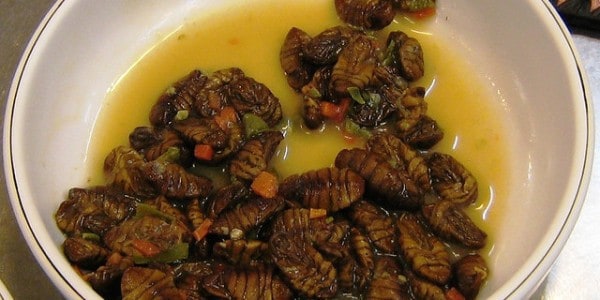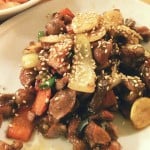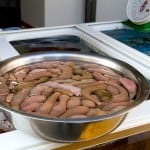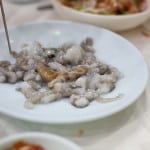I hope you brought your appetite with you, because today we are going to discuss some dishes truly unique to Korea! Some are loved and some are loathed, but one thing is for sure—they definitely do stand out. If you’re feeling brave, daring, and adventurous, then you might want to give some of these a shot.
For those who are looking for some new Korean vocabulary for their studies, we will also include the Korean names of each food so you can identify them if you go to a restaurant. If you want to learn Korean and being introduced to some new unique menu items, then you’ve come to the right place!
Note: If you’re dying to know how to pronounce the cool looking characters next to the words below, you can get a free guide to learn Hangeul (Korean alphabet) here. Most people learn to read in about one hour.
1. Beondegi (번데기) – Silkworm Larvae
This is a popular snack food in Korea that you can get from street vendors or that is served with drinks at some restaurants
The silkworm are first seasoned, and then boiled or steamed. Beondaegi have a somewhat soft and crunchy texture, and are served in a paper cup on the street or in a bowl at restaurants.
If you’re dying to get the home version, we have great news for you! Beondaegi can also be bought in sealed cans, so you can experience the delight anytime you get a craving.If you are brave and want to learn Korean, try translating the ingredients listed on the can!
2. Jokbal (족발) – Pig’s Feet
Jokbal is a beloved dish in South Korea which is made up of boiled pigs’ feet cooked with leeks, soy sauce, ginger, sugar, and rice wine. The feet are deboned, cut into slices and served on a large platter.
To eat, first grab a piece of lettuce. Next, wrap a slice of jokbal in the lettuce. Finally, add your choice of sauces, veggies, and other goodies, and you’re all set! Jokbal is said to be good for your skin and for hangovers, which works out well since it’s usually eaten alongside alcoholic beverages.
For those of you looking for the real deal, be sure to check out Jokbal Alley in Seoul (장충동족발골목 if you learn Korean), which is chock full o’ jokbal spots.
3. Dakbal (닭발) – Chicken Feet
While we’re on the topic of feet, let’s not leave our fine-feathered friends out of this one! While some of the food on this menu may not resemble the corresponding animal you are eating, dakbal is the exception. Make no mistake; you will know they are chicken feet!
The feet are cooked and seasoned with sesame and red pepper paste. Keep a pitcher of water or other beverage of your choice nearby, because they are spicy! 닭 means chicken, and 발 means foot. These are very useful words when you learn Korean!
4. Hongeo (홍어)– Fermented Skate
Due to overfishing and low reproductive rates in recent years, skate has become an expensive delicacy in South Korea. Skates are similar to stingrays. You probably wouldn’t be able to tell them apart if you saw two next to each other.
As far as adventurous dishes go, this one may be the winner. Famous for it’s ammonia-like odor and the ability to induce one’s gag reflex, hongeo is raw fermented skate served with various side dishes. It is most common in the southern part of the country.
To brush up on seafood vocab, learn these Korean words: 홍어 means skate, and 가오리 means stingray. Bon appetit!
5. Sundae (순대) – Boiled Intestine Sausage
First let’s address the pronunciation for our Korean learners. While the word may look like the delicious desert item the “ice cream sundae”, it’s actually pronounced like “soon” + “day.” Now that we can say it, let’s figure out what it is!
Also known as blood sausage, sundae is boiled or steamed cow or pig intestines seasoned with various ingredients and then packed together in sausage-like form. You can find this magical meat mix-up at many street vendors in South Korea.
6. Gopchang (곱창) – Grilled Pork or Cow Intestines
If you’re in need of a new dish to compliment a soju-infused night on the town, then you may want to consider gopchang.
Prepared in true BBQ style, you’ll sit at round table with a grill in the middle and be served a dish of seasoned grilled intestines ready to be cooked up. If you forgot to work out that day, not to worry —gopchang’s chewiness will certainly give your jaw muscles a serious workout!
Gopchang’s companions are typically onions, garlic, green onions, mushrooms, and hot peppers.
For those who want to learn Korean in Seoul and Busan, check out the Munhyeon Gopchang Alley in Busan (문현곱창골목) and Wangsimni Gopchang Alley in Seoul (왕십리곱창골목) to put your language skills to use.
7. Dak Dong Jib (닭똥집) – Chicken Gizzard
Looking to keep your skin looking healthy? Then you might want to look into some dak dong jib, since it has a reputation for contributing to healthy skin.
Made from the thick, muscular walls of the chicken’s digestive tract, this chewy delight is also known to cure hangovers. Doubly good!
Fun fact if you learn Korean: 닭 means chicken, 똥 means excrement, and 집 means house. Makes it quite easy to remember, but maybe you’ll want to briefly forget while you’re eating it!
8. Bosintang (보신탕) – Dog Meat Stew
The Korean word for the sound of a dog barking is “mung-mung” (멍멍). Sadly, you aren’t likely to hear that sound anywhere near a bosintang restaurant.
The dog meat is prepared and boiled with various vegetables and spices, including green onions and perilla leaves. Although not as popular with the younger generation, bosintang can still be found quite easily in Korea.
Some Koreans believe that the dog meat stew gives virility and stamina to men after they eat it.
9. Gaebul (개불) – Live Spoon Worms
If you’re in the mood for some fresh seafood, then gaebul might be for you!
These worm-like marine animals are chopped up into bite-size pieces while still moving for your chewing enjoyment. They are served with salt and sesame oil, and have a mild flavor.
They are famous for resembling a certain part of the male anatomy and also are rumored to be an aphrodisiac.
10. Sannakji (산낙지) – Live Octopus
If you’ve seen the movie Old Boy (올드보이 for the keen Korean learners), then you probably will never forget the legendary live octopus scene.
San (산) means “living” and nakji (작지) means “octopus”, and it is just exactly that.
Sannakji is served in different ways. Sometimes the tentacles are cut off and eaten immediately, while the body of the octopus is put into a soup. Alternatively, the tentacles may be served on a stick and eaten while still moving.
The body is cut up into small pieces and put into a bowl, to be enjoyed with sesame and sesame oil.
You may have noticed the frequent use of the word “live” in this paragraph. If you’ve never had your food moving around in your mouth before, then you may be in for quite a treat!
What are your favorite Korean foods? We’d love to hear from you, so feel free to leave a comment below!
Main Photo Credit: Zionorbi










 Learn to read Korean and be having simple conversations, taking taxis and ordering in Korean within a week with our FREE Hangeul Hacks series:
Learn to read Korean and be having simple conversations, taking taxis and ordering in Korean within a week with our FREE Hangeul Hacks series:
Recent comments